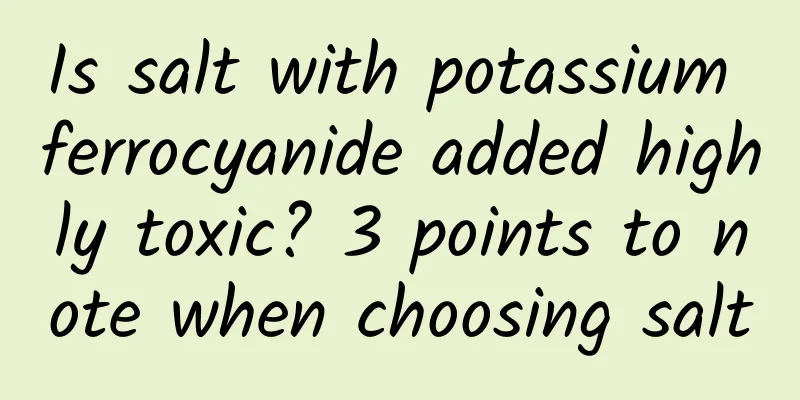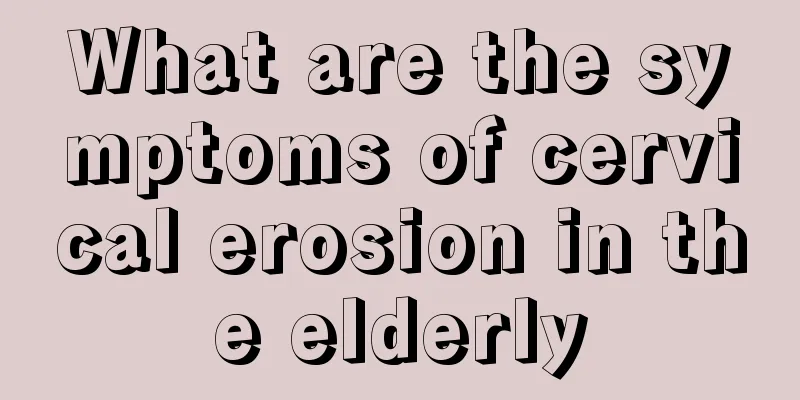Is salt with potassium ferrocyanide added highly toxic? 3 points to note when choosing salt

|
Recently, people often post such messages in the circle of friends and WeChat groups: Domestic table salt contains potassium ferrocyanide, which is highly toxic and cannot be eaten. I checked online and found that this is an old rumor from 3 years ago, and it has been debunked many times. I don't know why it was mentioned again recently, and many people are afraid to buy salt when they see potassium ferrocyanide. ▲Picture: Source: Internet Is potassium ferrocyanide really poisonous? Can we eat salt containing it? It seems necessary to talk about it. 01 What is potassium ferrocyanide? Legal anti-caking agent Potassium ferrocyanide is a food additive allowed to be added to food in my country. It can act as an anti-caking agent. The purpose of adding it is to improve the stability and sensory properties of table salt, and also to make it easier to transport and store. [1] ▲Figure: "Standards for the Use of Food Additives". Potassium ferrocyanide Because some table salt has a high mineral content and is prone to caking, potassium ferrocyanide, as an anti-caking agent, can be added to table salt to prevent it from clumping due to high mineral or water content. ▲Photo: A certain brand of salt As long as the added potassium ferrocyanide is within the safe range of permitted usage, there is no need to worry about causing harm to the body. Again, any behavior that ignores dosage and only talks about toxicity is unreliable! 02 Is potassium ferrocyanide toxic? It is not toxic in normal cooking The National Health Commission stated: The structure between iron and cyanide in potassium ferrocyanide is stable, and it can only decompose to produce potassium cyanide in an environment above 400°C; but daily cooking temperatures are usually below 340°C, so the possibility of potassium ferrocyanide decomposing at cooking temperatures is extremely small. Therefore, as long as you cook normally, you don’t have to worry about the production of toxic potassium cyanide. In addition, in terms of dosage: the ADI (acceptable daily intake) of potassium ferrocyanide is: 0-0.025mg/kg bw[2]. For a 60kg adult, the maximum allowable daily intake is 1.5mg. According to the recommendation of the "Dietary Guidelines for Chinese Residents", the daily salt intake is 6g[3]. If the daily potassium ferrocyanide intake is calculated according to the maximum usage of 0.01g/kg in the "Standards for the Use of Food Additives", the maximum is 0.06mg/d, which is far lower than the maximum allowable daily intake of 1.5mg/d for a 60kg adult. Therefore, there is no need to worry about the toxicity of potassium ferrocyanide in daily work and life. 03 What should we really pay attention to when choosing salt? When buying salt, we should shift our focus away from potassium ferrocyanide and pay more attention to the following three points: ① Whether it contains iodine: For areas and populations with iodine deficiency, iodized salt should be selected. For patients with thyroid disease or other people who need a low-iodine diet, non-iodized salt should be selected. ② Is it low sodium? For people with high blood pressure and other people who need a low sodium diet, low sodium salt can be chosen. At the same time, you need to pay attention to the potassium content. Generally speaking, low sodium salt has a higher potassium content. ③ No need to choose: There are some salts on the market that are fortified with other nutrients, such as "calcium salt", "zinc salt", "iron salt", etc. This type of salt is not recommended for everyone to buy. Although there are fortified nutrients, the recommended daily intake is still less than 6g, and it does not supplement much nutrition. For example, the calcium-fortified salt shown below, based on 6g of salt per day, can only provide 7.5g of calcium, which is only 0.9% of the daily calcium requirement of 800mg/g. [3] ▲Figure: Nutritional composition table of a certain brand of calcium salt To sum up: it is normal for table salt to contain potassium ferrocyanide, and it will not be toxic if used in normal cooking. We remind you to control your salt intake. A high-salt diet is harmful. It not only increases the risk of high blood pressure, but is also one of the main factors that induce gastric cancer. The daily salt intake per person should not exceed the cap of a beer bottle (<6g). References: [1]. GB 2760-2014 National Food Safety Standard Food Additives Usage Standard http://down.foodmate.net/standard/yulan.php?itemid=42543 [2]. Liu Zhongdong. Food Additives: Southeast University Press, 2006: 191 [3]. Chinese Nutrition Society. Dietary Guidelines for Chinese Residents[M]. People's Medical Publishing House, 2016 Author | Xue Qingxin, member of Chinese Nutrition Society, registered nutrition technician, health manager, public nutritionist Review | Gao Chao, Associate Researcher, Institute of Nutrition and Health, Chinese Center for Disease Control and Prevention This article was first published on the "Science Rumor Refutation Platform" |
<<: What does konjac taste like? What is konjac delicious with?
>>: Working for you 24 hours a day, just because you are its whole world...
Recommend
Is it comfortable for a woman with a big mouth?
There are rumors on the Internet now that women w...
Neoadjuvant chemotherapy for breast cancer
Neoadjuvant chemotherapy not only makes surgical ...
Why do I have knee pain during pregnancy?
The knee is a very important part of the human bo...
What is the difference between an accountant and a cashier? Is it better to be a cashier or an accountant?
Accountants and cashiers belong to the financial ...
Fast heartbeat and headache after medical abortion
Cesarean section and medical abortion are two com...
It turns out that eating also requires learning!
Author: Lv Zhuo, deputy chief physician of Changc...
What are the small bumps around the vulva?
Female hygiene is particularly important. If you ...
Can I squeeze the pimples on my face?
Acne on the face is a superficial skin problem ca...
Will silicone underwear be infected with bacteria if worn repeatedly?
In summer, girls are particularly suitable for we...
It hurts, it hurts, I can't stop tearing my barbs! It's not because of vitamin deficiency, but because of this habit...
Expert of this article: Zhou Xiaobo, Doctor of Me...
What are the precautions after artificial abortion?
Women need to take certain care after an abortion...
When to add salt to fry celery? When to add salt to fry celery?
We all know that celery is a common vegetable. It...
Women have recurring acne around their chin
The recurrence of acne on a woman's jaw is ge...
What is the yellow tofu residue in vaginal discharge?
Leucorrhea is a small amount of substance secrete...
What is a peeled fish? Can you eat the peeled fish head?
The official name of the peeled fish is the green...









